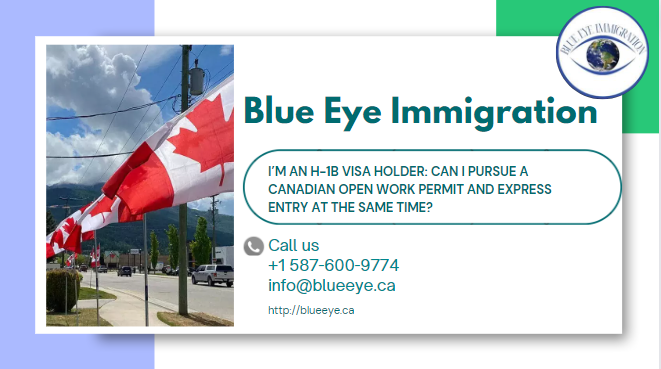Holders of H-1B specialty visas in the United States will soon have another pathway to live and work in Canada.
In addition to the existing permanent and temporary pathways, H-1B holders can apply for a new Canadian Open Work Permit (OWP) effective July 16. The new work permit will allow eligible H-1B holders and their immediate family members, such as spouses and dependents, to work for almost any employer in Canada for up to three years. Immigration Refugees and Citizenship Canada (IRCC) will accept applications for the new OWP for either one year or until the program reaches its cap of 10,000 applications in 2023.
As an H-1B holder, you may wonder: can I apply for a Canadian work permit and permanent residence at the same time?
In short, the answer is yes and there are some good reasons why.
Benefits of applying for H-1B OWP and Express Entry
IRCC aims to process applications for most work permits submitted outside Canada within 60 days, however certain pathways such as the Global Talent Stream have shorter service standards.
If you are already eligible, and wish to apply for permanent residence, you may wish to do so via the Express Entry application management system. Express Entry is the main way the Canadian government manages skilled worker immigration applications. Candidates in the Express Entry pool are evaluated on several human capital factors and assigned a Comprehensive Ranking System (CRS) score. Those with the highest scores are the most likely to receive an invitation to apply (ITA) for permanent residence.
If you have not lived or worked in Canada before, chances are you will need to assess your eligibility under the Federal Skilled Worker Program (FSWP) if you wish to pursue Canadian permanent residence via Express Entry.
One major advantage of Express Entry is that it has a service standard of processing permanent residence applications within six months.
This means you can upload your Express Entry profile onto the Canadian government’s website, and use the H1-B OWP as a means of entering Canada to live and work while you are seeking permanent residence.
There is also a benefit to applying for the OWP first, and then Express Entry once you are in Canada. Gaining at least 12 months of eligible work experience in Canada may result in a higher CRS score, which can support your chance of getting an ITA.
Another perk of at least one year of eligible Canadian work experience is you can become eligible for Express Entry’s Canadian Experience Class (CEC) program, thereby becoming exempt from demonstrating you have sufficient settlement funds (which is required under the FSWP).
Overall, H-1B holders are well-placed to apply for permanent residence through Express Entry as they have high human capital such as skilled work experience, post-secondary education, and strong English language abilities. This is demonstrated by the IRCC year-end report on Express Entry for 2021 which shows that the U.S. was among the top five countries of residence (not necessarily citizenship) for Express Entry ITA recipients between 2019 and 2021.
Express Entry for STEM occupations
Canada’s immigration minister, Sean Fraser, recently introduced a tech talent strategy that will work to further Canada’s reputation as an attractive destination for skilled tech workers. The H-1B OWP is one component but another key piece is the recent introduction of category-based selection draws for Express Entry candidates with specific, in-demand occupations.
Rather than simply issuing ITAs based on a high CRS score, category-based Express Entry rounds of invitations are aimed at selecting the economic immigration candidates who can best fill critical labour force gaps in Canada’s economy. The categories were chosen following IRCC discussions with provinces, territories, partners and stakeholders to identify the most urgent vacancies and skills gaps. There are 82 occupations that are eligible under the six new categories.
The Express Entry category for science, technology, engineering, and mathematics (STEM) workers has 35 eligible occupations. The first round of invitations for STEM occupations took place on July 5 and invited 500 candidates with a minimum CRS score of 486.
IRCC’s 2021 Express Entry report also showed that software engineers and designers, information systems analysts and consultants, computer programmers and interactive media developers consistently ranked in the top occupations for ITA recipients between 2019-2021. These occupations are all listed under the eligible occupations for Express Entry STEM candidates.
Other pathways for tech talent
Other components of Canada’s new tech talent strategy include a new innovation stream under the International Mobility Program, marketing Canada as a more attractive destination for digital nomads and making improvements to existing tech immigration programs such as the Global Talent Stream and the Start-up Visa Program.
H-1B holders can also apply for nomination through a tech stream of the Provincial Nominee Program (PNP), even without being in the Express Entry application pool. Getting a provincial nomination is highly beneficial when applying for permanent residence and makes a non-Express Entry application stronger. For those who are Express Entry candidates, getting a provincial nomination can add 600 CRS points to your profile. These 600 CRS points virtually guarantee you will receive an Express Entry ITA for permanent residence.
Most Canadian provinces and territories (except Quebec and Nunavut) can nominate the candidates that they believe to be best suited to the provincial labour force. Many provinces also have specialized streams within their PNPs for tech candidates. For example, British Columbia holds draws for tech candidates several times a month and Ontario recently held a draw targeting tech candidates in the Ontario Immigrant Nominee Program.
Overall, there a many pathways to permanent residency in Canada and H-1B visa holders with the new OWP can support their journey by applying for Express Entry after arriving in Canada. H-1B OWP holders have the advantage of high human capital and can also now benefit from the introduction of the STEM category-based Express Entry rounds of invitation.
